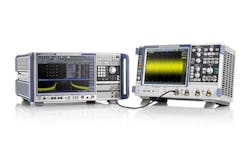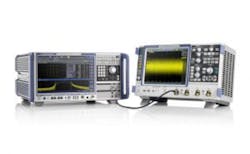Signal analyzer achieves 2-GHz analysis bandwidth
Rohde & Schwarz is expanding the analysis bandwidth of its R&S FSW high-end signal and spectrum analyzer to 2 GHz by introducing the new R&S FSW-B2000 hardware option. This test solution enables R&D users to demodulate extremely wideband signals and analyze them in detail. With the large analysis bandwidth and a frequency range up to 67 GHz, the FSW opens up numerous applications. For example, users can measure the EVM values of communications signals or the chirp rate on chirped radar systems.
To analyze a signal with such a large bandwidth, the R&S FSW downconverts it to an intermediate frequency, which is then wideband-digitized by an R&S RTO oscilloscope. The R&S FSW equalizes this digital signal and adjusts the sampling rate. The entire signal path including the oscilloscope is calibrated. Users control the easy-to-operate setup via the analyzer, which also displays measurement results. R&S FSW measurement applications such as vector signal analysis or pulse and transient measurements make it possible to analyze the signal in detail.The performance features offered by the R&S FSW make the instrument suitable for developers of devices and components complying with IEEE 802.11ad, the latest WLAN standard, enabling the transmission of high data rates over short distances. IEEE 802.11ad signals have a symbol rate of 1.76 GS/s in single-carrier mode and require 2 GHz of analysis bandwidth for demodulation.
The R&S FSW-B2000 option for the R&S FSW26 to R&S FSW67 high end signal and spectrum analyzers with frequency ranges up to 26.5 / 43.5 / 50 / 67 GHz is now available from Rohde & Schwarz.
http://www.rohde-schwarz.us/en/product/fsw-productstartpage_63493-11793.html
About the Author

Rick Nelson
Contributing Editor
Rick is currently Contributing Technical Editor. He was Executive Editor for EE in 2011-2018. Previously he served on several publications, including EDN and Vision Systems Design, and has received awards for signed editorials from the American Society of Business Publication Editors. He began as a design engineer at General Electric and Litton Industries and earned a BSEE degree from Penn State.

